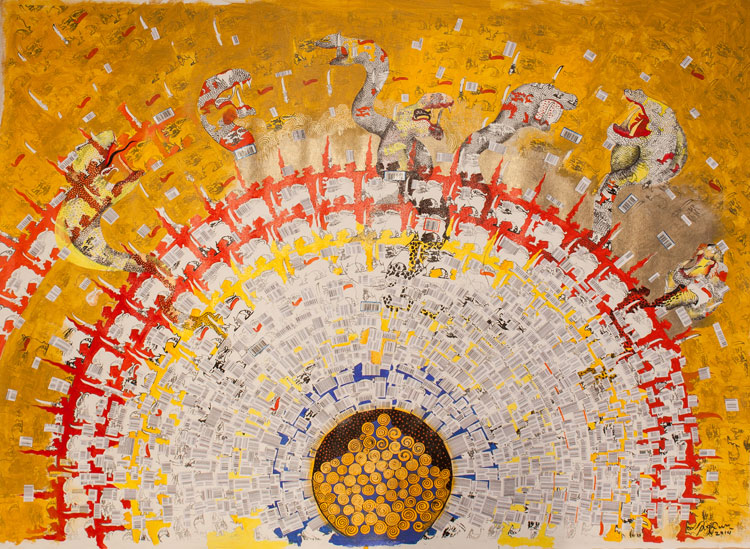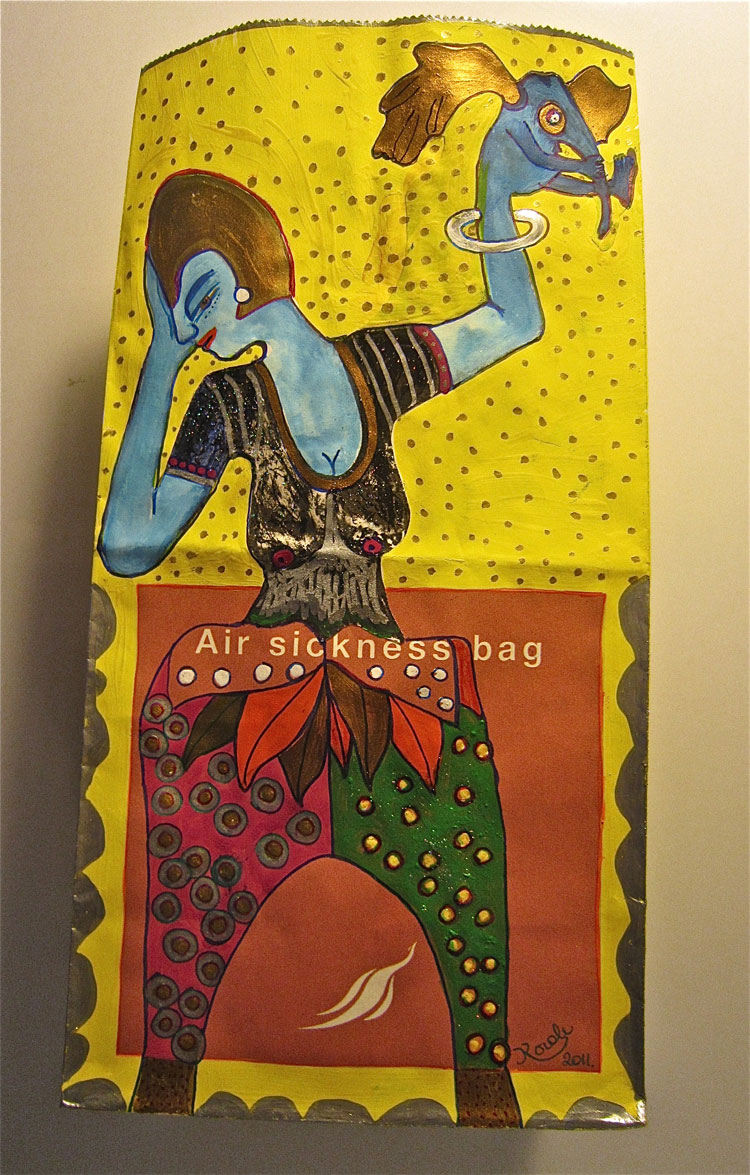“Serendipity Revealed” is an exhibition of modern art from Sri Lanka currently showing at Brunei Gallery in the heart of London. It is an exhibition that, in its own words, tries to tell Sri Lanka’s untold stories through the island’s “foremost and emerging contemporary artists.” Annoushka Hempel, the exhibit’s London-born curator — and who I assume is not Sri Lankan — presents the country’s diverse arts scenes as having thrived in the shadows of war despite little international recognition.
Sri Lanka’s artistic insularity has meant that the work remains largely unknown—exotic, if you like—to outsiders. The show, however, is not simply about providing exposure to this work, but selling it to Western art collectors. When the commercial aspect of an exhibition is its most important aspect, it becomes necessary to interrogate who reveals what to whom, and at what price.
The exhibition on post-war Sri Lankan art is the result of a collaboration between the Colombo-based Hempel Galleries, the Colombo Biennale (founded by Hempel’s director, who also curated the exhibit) , and the Brunei Gallery at the School of Oriental and African Studies in London. Hempel Galleries is not just any ordinary young arts gallery located in Sri Lanka’s capital. Its main exhibition space is located in Colombo’s most elite district, Cinnamon Gardens. The gallery’s sponsors reveal as much about the exclusivity and inherited privilege of the place as does its geography.
Rasmalawa; Nimbus, 2014 by Pala Pothupitiye
Sri Lankan Airlines is a chief sponsor of the project. The airline, it should be noted, is 94.68 percent owned by the government, and one of its Board of Directors, Shameendra Rajapaksa, is the Sri Lankan president’s nephew. In Sri Lanka, proximity to the centres of power is more than just a question of convenience or geography; this is true for the gallery, curator and its supporters. Ever since the election of its current president, Mahinda Rajapakse, the country has been run as an oligarchy and dictatorship with almost absolute and arbitrary powers. To be in the good books of the regime, it requires the proximity and alliance with its representatives and proxies.
The company’s involvement and interest in this exhibition—and therefore also the government’s—is further exemplified in the exhibition catalogue accompanying the show. The catalogue’s foreword was written by Sri Lankan Airlines CEO Kapila Chandrasenha. In it, he praises the project as representing a “carefully selected collection of Sri Lankan artists.” The same language highlighting selection and exclusivity is used by the curator and is echoed in the welcoming statements posted at the entrance of the exhibition. But who exactly is selected for this show?
Next to the “Welcome” sign is a list of the artists included in this exhibition. Of the fourteen artists included in the exhibit, nine are of Sinhalese-descent, two are of Tamil-descent, and one of Argentinean/German-descent. Before we ask about the sole white artist included by the curator, another more obvious question needs answering: where are the works of Sri Lankan Muslim artists in this exhibition? The side lining of such a significant part of the population is made all the more troubling when we consider all the noteworthy Muslim artists active on the Sri Lankan scene. If there is space for a non-Sri Lankan to be included in the show, surely a single Sri Lankan Muslim could have been included?
We should also question why the contributions of Tamils are reduced to that of merely two artists, Reginald Aloysius and Nina Mangalanayagam. Given the exhibition’s claim to reflecting post-war Sri Lankan society, as well as its many stories, experiences and identities, this seems like more than simply an underrepresentation. The absence of Tamils in the show is especially important to consider given that the country’s recent war was written, waged and performed primarily and most violently on Tamil bodies. In spite of the trauma and memories of violence—and perhaps in order to deal with and live with those experiences—Tamil artists have long produced a rich and tragic tradition of artistry and multimedia storytelling.
More troubling still is the fact that the only two Tamil artists included are both diasporic, whilst only one Sinhalese artist appears to be so. This is a strange, given the exhibition’s promise of showcasing arts (not artists) from Sri Lanka? Is it the case that there simply aren’t enough local Tamil multimedia artists? Was the premise that Tamils had all fled and become diasporic? Or was it too difficult, too tedious, to trace locally-produced art which aren’t as popular, as normative or as accessible?
Both Reginald Aloysius and Nina Mangalanayagam are fine artists, to be sure. But their works are diasporic products that centre around migration, identity, transnationalism and transformation. Neither addresses the most obvious Sri Lanka-based events that produced flight and the need for transformation in the first place: war, genocide and occupation. Tamil arts need not be reduced to addressing solely these factors, of course, but it’s impossible to divorce these encounters from specific group and individual experiences, particularly when presenting “Sri Lankan” arts as products in a “post-war era.”
In her curator’s note, Hempel speaks of the dangers and difficulties that artists face during war. The physical danger was, however, mostly carried by those who are excluded from this show, thus rendering them unable to present and/or represent those “dangerous” experiences. They have never had the chance to be seen and considered by anyone, including themselves, as part of the island’s so-called “modern art” movements. It is, therefore, important to consider the truths that are being constructed around such state-representing, rather than nation-rebuilding, efforts.
Hempel’s note further reveals her attempts at de-ethnicizing and deracializing the Sinhalese artists included in the show, while those who are diasporic who are, except one, all Tamil, remain ethnicised/racialised. Those who are based in Sri Lanka are, despite carry an ethnic, racial and religious identity – namely that of being, for the most part, Sinhalese Buddhists – “Sri Lankanised”. This practice of de-racialising “locals” whilst racialising those in the diaspora falls into the larger pattern of post-war discourse in Sri Lanka and its diasporas.
It can today be traced in the language of the state, media, the arts and even academia, where “Sri Lankan”, a relatively novel civic identity, is used as a post-war identity that replaces and displaces previously dominant ethnic and religious identity markers. As a post-war construct and state-backed policy, it aims to impose national unity in times of disunity and obfuscate inequalities as well as differences between groups by discursively reintegrating what remains divided. It is a product that thrives and remains co-existent to a landscape ‘cleansed’ off Tamil militant resistance, which for over several decades militantly challenged the hegemony of the unitary, centralist and Sinhalese-led state .The “Sri Lankanisation” of the fourteen Sinhalese artists in this exhibition underlies two assumptions: that everyone in the “local” scene is Sinhalese or that their names are foreign enough for outsiders, non-“Sri Lankans”, to be misunderstood as representative of all racial, ethnic and religious groups of the country.
Making “Sinhalese” synonymous with “Sri Lanka” and “Sri Lankan” obfuscates the issues of representation and inequalities at hand by invisibilising privilege and lack thereof between members of the so-called “Sri Lankan community”. Sinhalese people, who form the overwhelming majority population in the small island, have since postcolonial times been overrepresented in all spheres of life. Ever since 1948, their privilege is to remain invisible as a people, ethnicity and race as well as to have the right and power to decide when their ethnic and racial markers need to be emphasised and become visible.
Circus, Flight bag, 2011 by Cora de Lan
Tamils, on the other hand, and especially those who fled the country and are exiled, remain marked, hypervisible and vulnerable in Sri Lanka and beyond. Their identities cannot be hidden or replaced. Majoritarian society renders them coloured and biased. Tamil interpretations and experiences therefore cannot—because they are largely obscured—be seen or become universal. Tamil artists’ visions and experiences hold less weight, importance and meaning; they can easily be overlooked, overwritten, displaced, dismissed or simply be “forgotten.” As for Muslim artists, their works have hardly ever found any appreciation or representation amongst the “Sri Lankan” mainstream. Their erasure from this exhibition coincides with the rise in state-sanctioned Islamophobia in the country during the post-war years, and reflects an even grimmer image about what kind of Sri Lanka this exhibition aims to produce as well as represent.
As a result, the only works that directly refer to the Sri Lanka’s war-torn areas, which are virtually all Tamil and Muslim regions, are by Sinhalese artists. Some of them are, unsurprisingly, problematic to say the least. Such works are, necessarily, outsider interpretations. These curatorial decisions about who’s included, and who’s excluded, artfully reproduce a cycle of oppression, silencing, and marginalisation that reflects what has been happening in a variety of spaces in contemporary Sri Lanka. The interpretations of war and conflict are left to the “victors” of Sri Lanka’s war, who appear as voyeurs hidden as tourists, mass-murderers hidden as soldiers, settlers hidden as charities, interpreters hidden as artists. The past, present and future and their respective interpretations are firmly held in the hands of those who continue to orchestrate the vision of a war that was meant to eject an ethnic minority, take control of their property and lands, and erase as much of the existence of their civilisation as possible.
None of this is to suggest that the exhibition is without merit. Aesthetically, the arts presented, and Hempel’s curation, are wonderful examples of a rich and thriving modern art scene emerging from the geographic margins of South Asia and its diasporas. It is, however, difficult to overlook the fault lines of this ambitious project, which aims to present and represent what is, in reality, an unpresentable truth. As someone who appreciates the modern arts, I was visually and aesthetically pleased by the show, but politically and socially disturbed. I was, however, not shocked by what I took in. “Serendipity Revealed” is, despite being sponsored by a Sri Lankan government-owned company, a critical enterprise which responds to many important themes affecting Sri Lanka’s different societies.
The art on view touches subjects such as censorship, violence, caste, patriarchy and migration in many beautiful and creative ways. At the same time, however, the exhibit as a whole fails to address the crucial question of privilege. Would Tamil or Muslim artists be able to critically engage with the same or similar topics without risking their lives? Would they be able to specifically address and interpret the concerns of their communities and get away with it? And more importantly, would anyone in Cinnamon Garden, Galle Front or Bloomsbury be interested in seeing Tamils and Muslims narrating their own lives in the absence of translations and outside interpretations?
The exhibition overall misses the opportunity to bring the actual margins—not Sri Lanka vis-à-vis the international arts scene, but the state’s oppressed groups vis-à-vis majoritarian society—to the centre stage. This failure has big consequences: reproducing a comfortable, lazy, yet violent discourse that aims to solidify the status quo where victors write their history over burnt earth, vacant homes and absent cemeteries. But a nation cannot be peacefully imagined, built, photographed, photoshopped, drawn or curated upon the ruins of another without those ghosts being present, and making their presence felt.
Feature image: Bulletbook 1, 2014 by Kingsley Gunatilleke
Sinthujan Varatharajah is a doctoral student in Political Geography at University College London, University, He holds a Masters in Race, Ethnicity and Postcolonial Studies from the London School of Economics and Political Science and is the founder of Roots of Diaspora, a multimedia storytelling project on refugeehood and migration. Follow him on Twitter at @varathas.


